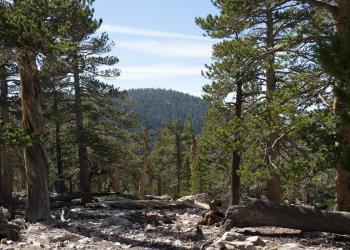Wildfire Risk Reduction
During the July 2024 Lake Fire in the Los Padres National Forest, hazardous fuels reduction treatments, defensible space, and community planning and preparedness were key to saving lives and structures.

Claire Price (left), and Kyle Hitchcock permanent seasonal firefighters on the Shasta Lake Ranger District, during a pile burn to remove hazardous fuels on the Shasta-Trinity National Forest December 6, 2022.
Photo Credit: (USDA Forest Service photo)In recent years, the USDA Forest Service has developed a robust strategy to address wildfire risk in the places where it poses the most immediate threats to communities, critical infrastructure, and natural resources. New initiatives combine funding with years of scientific research and planning into a national effort to dramatically increase the pace and scale of forest health treatments. The agency works collaboratively to address wildfire risks to critical infrastructure, protect communities, and make forests more resilient.
Wildfire Risk Reduction in Southern California
The Forest Service combines funding, traditional knowledge, scientific research, and planning into a national effort to help reduce wildfire risk. In Southern California, four National Forests—the Angeles, Cleveland, Los Padres, and San Bernardino, make up the Southern California Zone. The region’s diverse geography presents unique challenges for wildfire risk reduction. In an area home to millions, wildfires threaten homes, lives, and ecosystems. Prevention is key. The vast majority of wildfires in Southern California are human-caused. Reducing wildfire risk is everyone’s responsibility. Learn more about Reducing Wildfire Across Southern California (PDF 1.4 MB), or en Español (PDF 1.4 MB).
Four Cornerstones
Across the Southern California Zone, four central cornerstones provide a framework to help reduce wildfire risk. Explore each cornerstone below.
Ignition Reduction

Did you know, most wildfires in Southern California are started by people? Escaped campfires, improper towing, or parking on dry grass along roadways can all spark a wildfire. The good news is, we can all work to prevent wildfires before they start by reducing ignitions in the first place.
Strategic Fuelbreak Networks

Fuelbreaks are areas without woody plants along ridgelines, roads, or powerlines. As wildfire moves into or out of communities, strategic fuelbreak networks give firefighters a safe place to stop or slow the spread of wildfire.
Montane Forest Conservation

Many of Southern California's treasured recreation areas are within sky islands – patches of forest found on mountaintops and higher elevations. Yet these forests are under threat from wildfires, droughts, pollution, and invasive species. Maintaining the health of our montane forests can reduce wildfire risk and benefit both humans and wildlife.
Community Planning & Preparedness

Are you prepared for wildfire? Wildfires put homes, lives, and infrastructure at risk. Reducing your wildfire risk ahead of time is important. Hardening your home, creating defensible space around structures, and having an evacuation plan can help keep your family and community safe.
Where We Stand
The USDA Forest Service is making significant progress to address ongoing wildfire risk. In fiscal year 2024, a record 803,633 acres were treated across the 21 high-risk firesheds, surpassing fiscal 2023’s accomplishments of 765,450 acres. In total, 1.86 million acres have been treated across the landscapes since their establishment in 2022 and 2023. Focused work within the 21 fire-prone landscapes has resulted in reduced wildfire risk to $700 billion worth of housing and critical infrastructure. This includes approximately 550 at-risk communities, 2,500 miles of high-voltage transmission lines, and 1,800 watersheds that provide drinking water, as well as many other values that people depend on and care about. Thanks to this work, the communities, critical infrastructure, and natural and cultural resources Americans rely upon are becoming safer. Learn more in our annual update (PDF 6.9 MB).







